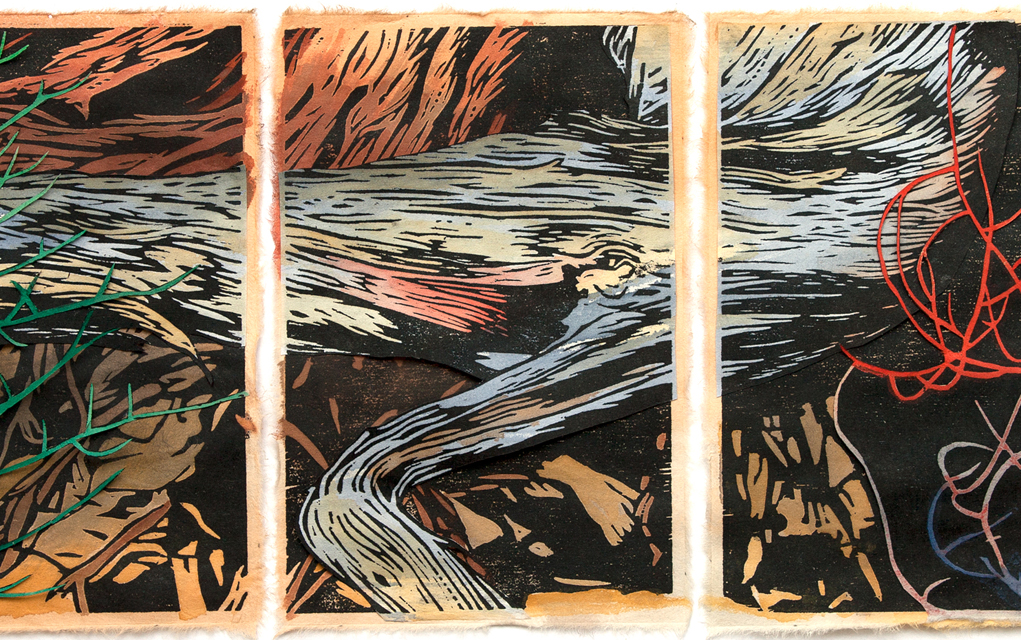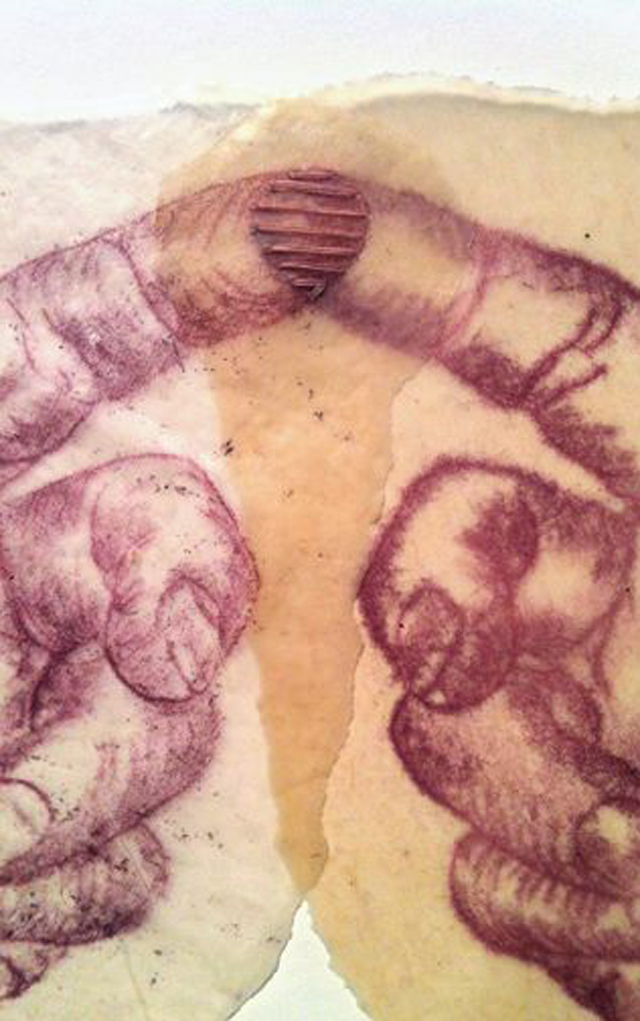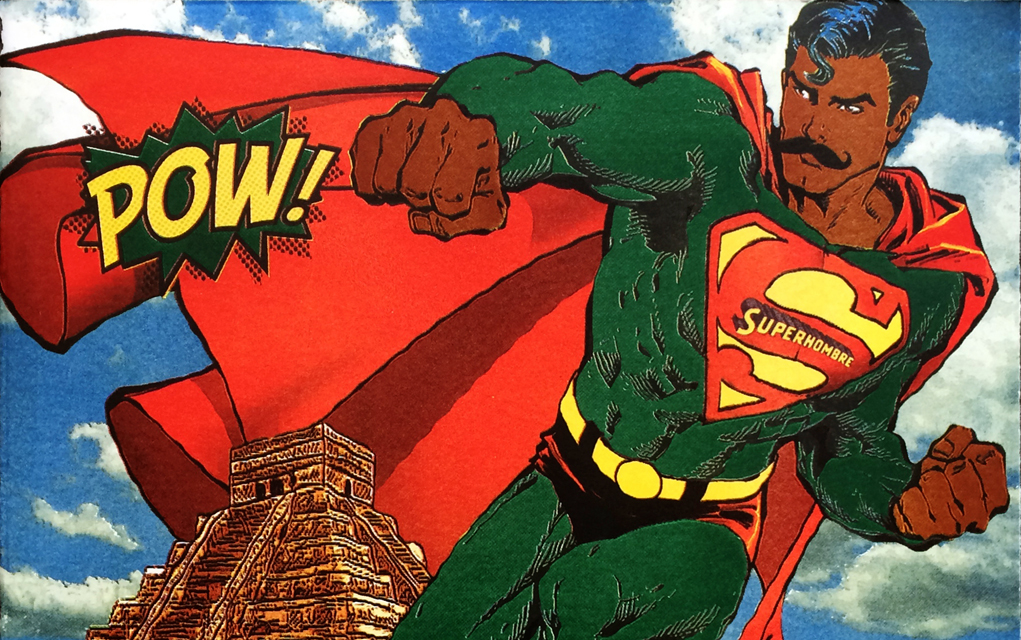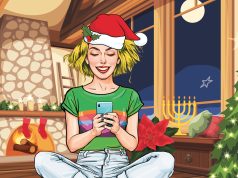
After meticulously carving out the perfect design, it is time to put the first round of ink onto the stamp and press it onto fine art paper. Excitement and anxiety build as the stamp is gently separated from the paper. The moment of truth comes when the image appears on the page. This is the art of printmaking.
In Denver and its surrounding cities, the art community alternates between recognizing March as the month of photography or the month of printmaking. In celebration of this year’s printmaking March, the Firehouse Art Center is displaying the work of printmakers from the West through April 4. Curator for the exhibit is Melanie Yazzie, a contemporary Native American printmaker, jewelry designer, sculptor and printmaking professor at the University of Colorado.
“They’re really amazing artists that aren’t all together at the same time,” Yazzie says. “They’re printmakers that people should know about, and often people don’t know of these [artists]. And so the title being Encounters, so people can encounter these artists.”
Yazzie’s own artwork is also in the Encounters 2016 exhibition alongside the work of 12 other artists. Her prints in the show are a series of abstract monotype pieces. Monotype is a printmaking process that involves carving a desired design into a flat glass, copper or acrylic surface and then transferring that design onto paper.
Other than showing printmaking from artists and art educators from the West, there is no specific theme that unifies the pieces in the exhibition. The content of the prints varies with each artist — a few pieces are abstract, while others are detailed and realistic; some of the artworks are about nature and some are about society.
“It really depends on the piece and the person who’s made the work,” Yazzie says. “And they’re all responding to different things that are happening in their own communities or their own research. I’m sorry to be very vague, but it’s just hard to say because some people are making images about their identity. Some pieces are about historical things in the current events that are happening in the world. So there’s a wide range of things.”

Printmaking can be hard to define because it can include several different types of art processes and mark making. One of the key elements of printmaking is the process of duplication.
“We’re in the age where we have 3-D printers, and the whole idea of duplicating something is what making is about,” Yazzie says. “And it’s not just on paper anymore. It’s on glass, stone, wood. There’s all different types of things that have been inspired by printmaking that have led into engraving images onto gigantic signs that advertise things. So it’s anything and almost everything.”
Printmaking is a complicated art form because it can have broad definitions while simultaneously having strict constraints. Yazzie says a common misunderstanding about printmaking is the difference between a poster and a fine art print. Yazzie considers series that have 100 or fewer prints and that are on fine art paper to be fine art prints.
The month of printmaking is important for both the public who views the art and for the printmakers who share the excitement of having a month dedicated to their artwork.
“The month of printmaking is a really great way for the public to learn what printmaking is and all the iterations it can take,” says Denver-based fulltime artist and art educator Jennifer Ghormley, whose art is featured in the Firehouse exhibit. “It is also like an extended family reunion, where printmakers come out of their studio hibernation and interact with one another to celebrate through their artwork.”

Ghormley’s pieces in Encounters 2016 are monotypes that were waxed and then sewn together.
“The imagery is of two hands, actually the same hand gesture mirrored,” Ghormley says. “The two prints are stitched together where finger tips overlap. To me, these pieces are about the relationship with the self, and how we create our own lives. So it is imperative that we are close to ourselves as that relationship informs everything else in our lives.”
While artists often choose to title their work, Ghormley chose not to for her series in Encounters 2016.
“I did not title this series, as words can be so declarative,” Ghormley says. “And I like the viewer to draw their own conclusions, based on their own experiences, as to what the work is about.”
Another artist on display in Encounters 2016 is Denver-based artist Leon Loughridge. As a fulltime artist, he has several tasks in addition to creating art.
“Managing a studio means that I have multiple job descriptions, from accounting to shipping,” Loughridge says. “But mainly, I get those chores done quickly so that I can move onto my true love of printmaking.”
Loughridge uses the art form to make his vision come to fruition.
“Understanding and controlling the technical challenges presented by the printmaking medium allows me to treat them as expressive tools, and not as limitations,” Loughridge says. “When the handling of a medium becomes intuitive, the analytical process of building and creating a printed image becomes as invigorating as the original sketch was in the beginning.”
Being raised in New Mexico, Loughridge’s woodblock prints are often influenced by the landscape of the western U.S.
“The two prints in the exhibit were developed from onsite watercolor sketches that captured the essence of the scene, the atmospheric drama that inspired me,” Loughridge says. “The challenge of interpreting or translating a spontaneous quick sketch into a block print is to capture the energy of the original in print, not to merely duplicate the image.”
Loughridge’s printmaking process begins with drawings of what he wants the piece to look like. Then, he uses what is called a reduction process, which means he carves a design into a woodblock and then imprints that design onto paper using ink. Then he carves out more details and prints it again and the process repeats until he is done. Loughridge says this method gives him a combination of the freedom of drawing through the medium of printmaking.
“I tend more towards representational imagery but am intrigued by abstraction,” Loughridge says. “I do feel that each piece should have a core abstraction to be effective. I am greatly influenced by my environment and love to portray the mountain scenery that is so inspiring to me in my work.”

As printmaking grows in popularity, Yazzie hopes more people experiment with the art form and its many variations. One way to do so is to stop by the Firehouse for a printmaking class led by Chris Blume from Flatiron Press on March 17.
“People should just take a printmaking class or learn how to make a print and become part of this art-making movement,” Yazzie says. “It’s very empowering and can help you get your voice into the world in a beautiful way.”
On the Bill: Encounters 2016. Firehouse Art Center, 667, Fourth Ave., Longmont, 303-651-2787. Through April 4. Printmaking Workshop. 4 p.m. Thursday March 17.














